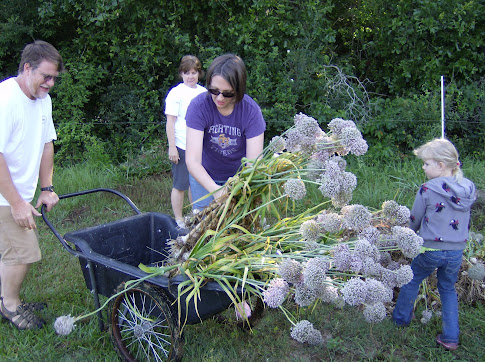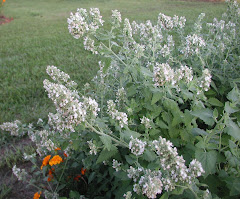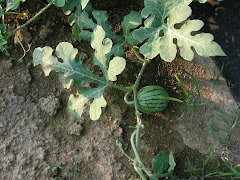
...last week of the CSA; we're down to okra, squash, and one more watermelon for everyone. Yeah, hot peppers, but how many of our members want more of THAT? (answer: not many). Week 6, everybody got rosemary jelly as a 'supplement' to their market basket. Week 7, everybody got a jar of Hot Sweet Garlic Pickles AND a container of Dill Dip (very popular!). So, Week 8, Will makes pepper jelly and I decided that everyone would get a loaf of herb bread! Sounds good in theory, I suppose; and I have lots of experience with bread-making...especially this recipe. But 24 loaves of bread????? All having to be baked on Friday so everybody gets it fresh??? Good Grief! Luckily, I have a friend with a counter stand-mixer, so she lets me borrow it. I figured I could just whip out 24 batches of dough on Thursday, rise them once, put them in plastic bags in the fridge, and bake them all on Friday. this also sounds good in theory. right?
NOTE: This is a pretty long rant about bread-making, so if you're not well for it, you can just look at the pictures and get on with life!
So I go to the store and load up: 15 bags of flour, four jars of yeast...
I experimented on Wednesday. just to see what happens when you try to preserve dough for baking the next day- the only smart move so far. I made a regular batch of bread, by hand, put the dough in a plastic bag in the fridge. It just kept on rising and rising in the coldness of the fridge! It just wouldn't STOP! At this point, I realized I'd have to freeze all of them first, THEN put them in the fridge for later use. (Note: once they unfreeze, even in the fridge, guess what? yes. they keep rising. That little item I'd find out much later. So I just forged ahead. I had already planned to do this, and it was our only plan, so I had to go with it.
Thursday morning, I pick up from said friend's house the Kitchen Aid Accolade 400! I mean, who on earth decided to name a mixer the Accolade?! That's a car name, or it should be.
First, I just figure I'll do it the way I always do; no measuring, just rise the yeast and alternate hot water and flour until I get the right amount and consistency. Do not try this in a standing mixer! The mixer will have none of it! I wound up #1 with a great glob of goopy mess that of course never turns into a dough ball while using the dough hook attachment! But I had been smart, and knew from reading online conversations about this appliance that the dough wan't ever going to do that anyway. #2, I thought it would be a good idea to wrap the first two I did in wax paper before putting them in plastic bags. big mistake. good thing I didn't continue to do that with the other 21 loaves. more later. #3, I really should have made sure they were all frozen solid before transferring them to the outdoor cooler. I was flying by the seat of my pants. I had ten loaves done by 1:00 p.m. I figured I was making good progress. From start to end on Thursday, I had been on my feet (I kid you not) for 12 hours! I had to drag myself through the last 4 or 5 loaves, because I was ready to jump off of a tall building by then. But, by 10:00 at night, I had 24 bags of dough, once risen and cooled down in the freezer, on the highest shelf of the cooler in the shed.
Friday morning, I figured this would be an easier day. My oven will only take three loaves at a time which is good, because I only have three loaf pans anyway. I go out to the shed and open the door. My goodness it smells like bread in here! Uh...one of the bags had exploded (remember the 'keep on rising' part?) and spilled all the way down the front of all the bee boxes stacked in the cooler. gross. I start hauling all the bags out, crossing my fingers. Although this was the only actual explosion, many of the bags had expanded and popped the ties on the bags...I brought all of them inside and began stuffing them into the two freezers. What now? I only have this one day! I chose three and set them on the table. The goal is to get the dough to room temperature before baking. well, I waited an hour and a half and that just was NOT happening. So I put the first three in the oven. yet another mistake. I buttered the tops at 20 minutes. I looked in at 45 minutes, figuring they'd be ready but the bread just wasn't baking all the way! I left them in for an hour, and the middles STILL weren't done! Patience, patience. Three loaves maybe ruined. One exploded and ruined..AND, the two wrapped in wax paper? Well, let me just say that the wax paper became ONE with the dough and there just wasn't any way to separate one from the other. into the garbage. That's three ruined loaves before baking and three baked loaves probably ruined also (although they looked alright, I didn't trust them at all).
Good thing I am a very determined woman. I hauled all of the loaves from the freezers out onto the carport, put the bags on trays and in bowls covered with plastic wrap and dish towels. The real challenge here is making sure that as they got warm enough to bake, they never came into contact with a fly. With everything covered with tablecloths, I felt pretty confident about that. The day progressed, and every round looked better than the one before. After putting the last three in the oven, I whipped up three more by hand..the baking was done by 10:00 p.m. But I did it!
 Like Will said, everybody will be excited with a loaf of bread in ther market basket, but nobody will think 'MAN, 24 loaves of bread!' No matter. Here is the basket everyone received on Saturday...Watermelon, Okra, Squash, Pepper Jelly, Bread, and herbs.
Like Will said, everybody will be excited with a loaf of bread in ther market basket, but nobody will think 'MAN, 24 loaves of bread!' No matter. Here is the basket everyone received on Saturday...Watermelon, Okra, Squash, Pepper Jelly, Bread, and herbs.
Our CSA Members seemed to be sorry the whole thing was over, eager to sign up for next year, and pleased with the whole experience. Hey! We managed to pull it off, beginning to end! Now, as we do every late summer, cut it all down, plow it all under, cover crop...and rest.






































































1 comment:
Are you STILL recovering from the bread-making? Any new farm news?! Would love to see an update on here!
Post a Comment